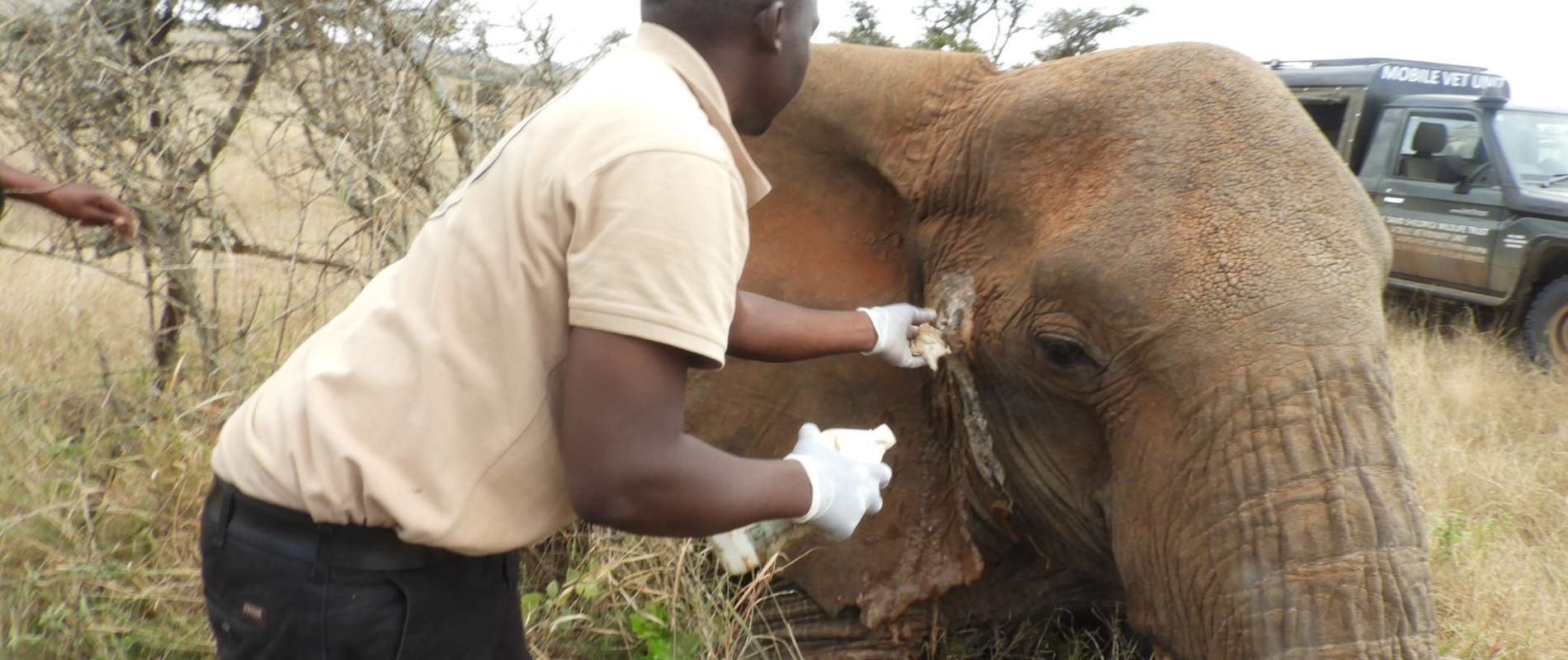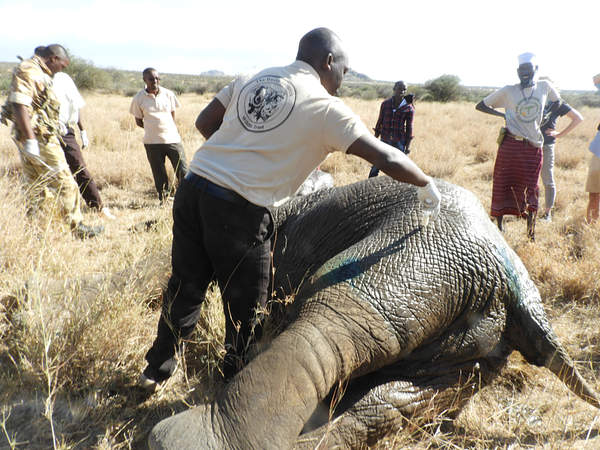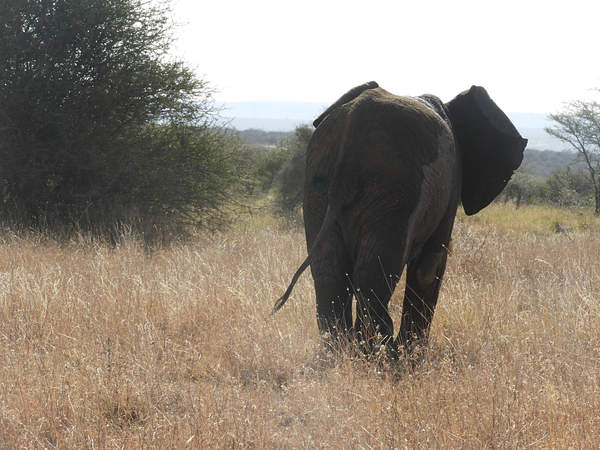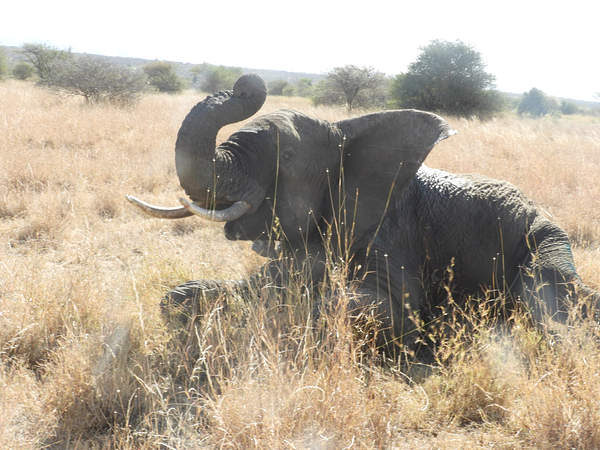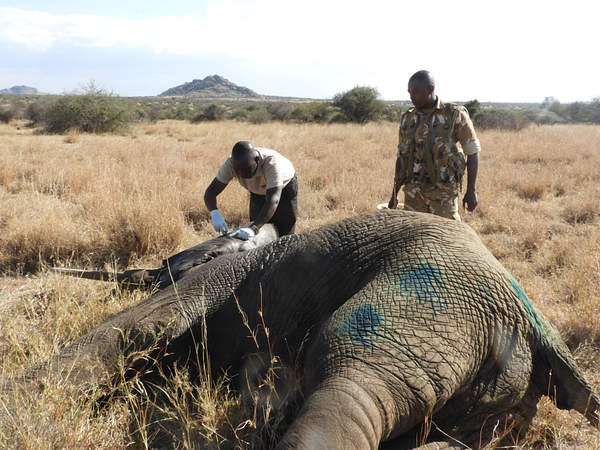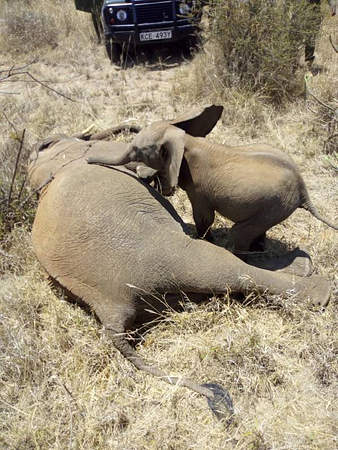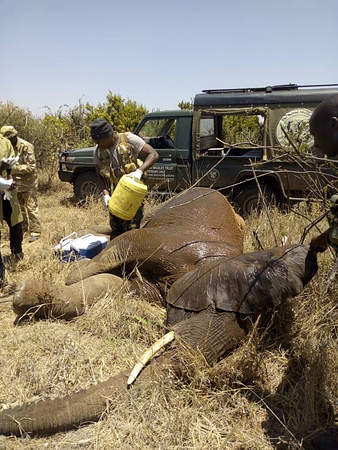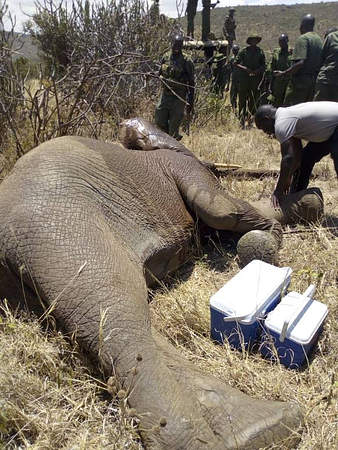Veterinary interventions intervention in the whole of Laikipia-Samburu ecosystem and Mt. Kenya region during the month of October, 2018 included treatment of an injured treatment of a sub-adult male elephant with bullet wounds on the leg at Ilpolei area, treatment of an injured elephant bull at Ole Nashuu Wildlife Conservancy, treatment of an injured female elephant at Enasoit Wildlife Conservancy, repeat treatment of an injured elephant at Loisaba and Karisia Wildlife conservancies.
Case #1: Treatment of an injured male elephant
Date: 3 October 2018
Species: African Elephant (Loxodanta africana)
Sex: Male
Age: Sub-adult
Location: Karisia Conservancy
History: This was a repeat treatment a sub-adult male elephant in Karisia Wildlife Conservancy that had sustained a fracture of the left hind leg at the level of tarsal joint. The elephant had made quite good improvements after being treated twice in Mpala Wildlife Conservancy in two months, but it required re-examination and repeat treatment to enhance its recovery. We used a helicopter from the David Sheldrick Wildlife Trust to dart the elephant and ensure it was immobilized in an open area for treatment.
Immobilization, examination and treatment: The injured elephant was darted from a helicopter using 16mgs of etorphine Hcl in a 3ml Dan-inject dart. Full immobilisation was achieved after about 7 minutes. The affected left hind leg had improved a lot and the swelling had subsided but the leg was still stiff and not flexing, it had no wound or any other external injury on the affected leg. The elephant was then treated with adequate dose of Vitamin B12 and Calcium (Calciject®) followed by Dexamethasone injection and multivitamin administered intramuscularly to reduce pain and enhance the recovery process. This was the third and last treatment since the elephant had recovered quite well.
Revival and prognosis: Soon after treatment, the elephant was revived from anaesthesia using 36mgs of diprenorphine Hcl combined with 50mgs of Naltrexone administered intravenously through the superficial ear-vein. The elephant rose up shortly and walked away feeling much relieved. Prognosis was quite good as it had responded quite well to the previous treatments and expected to recover fully after the third treatment. The elephant is being closely monitored by the security team at the Karisia Conservancy who have reported good progress.
Case #2: Treatment of an injured sub-adult male elephant
Date: 4 October 2018
Species: African Elephant (Loxodanta africana)
Sex: Male
Age: Sub-adult
Location: Ilpolei area
History: This was a case of a sub-adult male elephant sighted by community scouts from Ilpolei area in Laikipia County, it had a deep penetrating wound on the dorsal side of the left front leg. The elephant was in a herd of 4 bulls that provided protection.
Immobilization, examination and treatment: The injured elephant was found in a thicket forest where it was tracked for several hours by a vehicle and eventually it was darted on the thigh muscles using 15mgs of etorphine Hcl in a 3ml Dan-inject dart. The elephant had one deep penetrating wound on the dorsal side of the left front leg. The wound was still fresh and bleeding, a bullet head was retrieved from that wound, the bullet had pierced through the muscles and hit the carpal bones making several cracks on the bone.

The wound was properly cleaned with lots of clean water then probed using sterile gauze swabs attached to long forceps to remove all the necrotic debri and ensure no foreign material was left inside. The wound was then debrided with dilute 10% hydrogen peroxide then cleaned and flushed with tincture of iodine. It was further treated using Opticlox® ointment applied topically and green clay applied to plug off the wound followed by oxytetracycline spray.
Other treatments were intramuscular injection of Procaine penicillin (Norocillin®) and flunixine meglumine to support the wound healing process.
Reversal and prognosis: After treatment, the elephant was then revived from anaesthesia using 48mgs of Diprenorphine Hcl administered intravenous through the superficial ear-vein. It rose up feeling much relieved and followed the other male elephants. Prognosis was quite good after removing the bullet and wound treatment, quick recovery was expected since the wound was not yet septic.
Case #3: Postmortem examination of a male elephant
Date: 6 October 2018
Species: African Elephant (Loxodanta africana)
Sex: Male
Age: Adult
Location: Ol Pejeta Wildlife Conservancy
History: This was a case of an adult male elephant that was found dead in a small dam within Ol Pejeta Wildlife Conservancy. The carcass was still fresh and the veterinary Unit in Nanyuki was called to conduct investigation to ascertain the cause of death.

Postmortem findings: The elephant was quite emaciated and the left hind leg was swollen and atrophied, it had a fracture of the left femur. The fracture is suspected to have been caused by a fight with other bulls in the conservancy. It was then unable to walk out of water when the body condition became worse.
The tusks were recovered and handed over to KWS stores for safe custody.
Disposal of the carcass: The carass was pulled out of water for postmortem examination then later pulled using a tractor far away from water point and left for scavengers.
Case #4: Postmortem examination of an adult male elephant
Date: 7 October 2018
Species: African Elephant (Loxodanta africana)
Sex: Female
Age: Adult (Approx. 25 years)
Location: Suguta Marmar
General Observations: An adult female elephant was found lying laterally on the ground struggling and making several attempts to rise up but in vain. Both the tusks were intact. This was very close to the road and near the village. It had quite enlarged mammary glands exuding a lot of milk an indication that it had a young calf that may have escaped with other elephants or it was in the last trimester of pregnancy. The elephant was visibly in pain and helpless. The KWS veterinary team from Nanyuki was called to attend to it as soon as possible.
Immobilization, examination and treatment: The elephant was anaesthetised using 16mgs of etorphine Hcl, this was hand injected into the thigh muscles to calm it down and allow closer observation and manipulation to ascertain the cause of injury.

The elephant was closely observed and turned over while searching for signs of external injuries or any other signs of illness. The elephant had a deep wound on the right side of the neck close to the ear pinnae, the wound was about 10cm deep and had a lot of pus and exudates. The left hind and left front legs were completely paralysed and could not support the weight of the elephant. No other external injury or wound was observed apart from the deep wound on the neck.
Euthanasia: Following the clinical examination and the status of the animal, it was confirmed that the elephant could not rise on its feet and move, it was also in deep pain and quite stressed by being paralysed. A decision was made to euthanize the elephant by stunning it on the head.
Postmortem Findings: The deep penetrating wound on the neck extended to the vertebral column breaking the vertebral bones and affected the spinal cord that was septic and filled with a lot of pus. This led to necrosis and degeneration of spinal nerves that caused muscle paralysis and the elephant got paralysed on the legs and could not rise up any more.
Removal of the tusks and disposal of the carcass: After postmortem both the tusks were removed and kept under KWS custody. The elephant carcass was tied by ropes and towed using a 4-wheel drive vehicle to the nearby thickets away from the roadside.
Case #5: Treatment of an injured adult male elephant
Date: 9 October 2018
Species: African Elephant (Loxodanta africana)
Sex: Male
Age: Adult
Location: Ole Nashuu Wildlife Conservancy
History: This was a case of an adult male elephant sighted in Ole Nashuu Wildlife Conservancy, it was quite weak, limping and unable to move, the affected right front leg was quite weak and heavily swollen at the carpal joint and could not support the body. It had no external injuries and the elephant was still in good body condition.
Immobilization, examination and treatment: The injured elephant was found alone in an open area near a water point it was then darted from a vehicle using 18mgs of etorphine Hcl in a 3ml Dan-inject dart.
There was no visible traumatic injuries around the swollen leg, the affected leg was flexed and palpated thoroughly but was suspected to have sustained a closed fracture of the humerus bone this injury caused inflammation and a lot of pain hence the elephant could not put weight on the affected leg.

The elephant was then treated with Calcium injection (Calciject®), Vitamin B12 and dexamethasone injection to revitalize the nerves and reduce pain on the affected leg, further treatment with long-acting Betamox® antibiotic intramuscularly to treat possible internal infection.
Reversal and prognosis: The elephant was then revived from anaesthesia using 48mgs of diprenorphine Hcl combined with 50mgs of Naltrexone administered intravenous through the superficial ear-vein. It rose up after two minutes and moved away slowly feeling a bit relieved.

Prognosis was poor due to pain and its inability to move but it had good appetite and remained near the water source hence it has good chances of recovery. The elephant has since improved and was recently sighted in the neighbouring Borana ranch.
Our mobile vet initiative is in the field every day saving wild lives
Case #6: Treatment of an injured adult female elephant
Date: 9 October 2018
Species: African Elephant (Loxodanta africana)
Sex: Female
Age: Adult
Location: Enasoit Wildlife Conservancy
History: This was a case of an adult female elephant sighted in Enasoit Wildlife Conservancy, it was found alone next to the Enasoit tented camp, it was quite weak, limping and unable to move, the affected left front leg was quite weak and slightly swollen. It had no external injuries and the elephant had lost body condition.
Immobilization, examination and treatment: The injured elephant was found alone in an open area near the tented camp, it was then darted from a vehicle using 16mgs of etorphine Hcl in a 3ml Dan-inject dart. There was no visible traumatic injuries around the swollen leg, the affected leg was flexed and palpated thoroughly but was suspected to have sustained a dislocation of the knee (stifle joint). It also had a superficial wound on right side of the head close to the facial crest.

The elephant was then treated with Calcium injection (Calciject®), Vitamin B12 and dexamethasone injection to revitalize the nerves and reduce pain on the affected leg, further treatment with long-acting Betamox® antibiotic intramuscularly to treat possible internal infection.The wound on the head was also cleaned and debrided using 10% hydrogen peroxide followed by tincture of iodine and oxytetracycline spray.
Reversal and prognosis: After treatment the elephant was then revived from anaesthesia using 48mgs of diprenorphine Hcl combined with 100mgs of Naltrexone administered intravenous through the superficial ear-vein. It rose up after two minutes and moved away feeling relieved.
Prognosis was good after treatment and it has been reported to have improved much following the treatment.
Case #7: Repeat treatment of a lame female elephant
Date: 10 October 2018
Species: African Elephant (Loxodanta africana)
Sex: Female
Age: Adult
Location: Loisaba Wildlife Conservancy
History: An adult female elephant was sighted in Loisaba Wildlife Conservancy with one and half year old calf. It was found in a herd with other elephant family, it was quite weak and limping with a swollen right front leg. It had been treated twice earlier but had not healed fully hence required repeat treatment.
Immobilization, examination and treatment: It was found in a thick bushy area and after tracking it for some time it was darted from a vehicle using 15mgs of etorphine Hcl in a 3ml Dan-inject dart. Soon after darting the elephant ran into the nearby bushes and got immobilized after about 8 minutes and went down on lateral recumbency. The other elephants left but the calf was kept around while the mother was being treated.
The affected left front leg was still swollen due to a dislocation at the elbow joint but had no wound or any other external injury. The swollen leg was flexed and palpated to confirm the cause of the injury, it was suspected to have got dislocated either during mating or accidentally fell into the cliff.The elephant was treated with Vitamin B12 and Calcium (Calciject®) followed by Dexamethasone injection and Betamox® antibiotic administered intramuscularly to reduce pain on the joint and treat possible internal infection as the recovery process continued.
Reversal and prognosis: After treatment, the elephant was revived from anaesthesia using 48mgs of diprenorphine Hcl administered intravenous through the superficial ear-vein. The elephant rose up and was joined by the calf that was still nearby. Prognosis was good as it had improved much and had quite good body condition and it was still strong enough to support to protect its calf.
ACKNOWLEDGEMENT
Report by KWS Vet Dr Mijele. We sincerely acknowledge the David Sheldrick Wildlife Trust (DSWT), KWS team at the veterinary department and at Mountain Conservation area and other partners for supporting and coordinating the Mt. Kenya Veterinary Unit to respond and save many wildlife cases that required urgent veterinary attention particularly the elephants that are really affected by human-elephant conflicts in the region.
